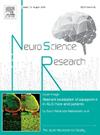Projection-specific and reversible functional blockage in the association cortex of macaque monkeys
IF 2.3
4区 医学
Q3 NEUROSCIENCES
引用次数: 0
Abstract
The functional manipulation techniques based on optogenetics have been widely and effectively utilized in the rodent brain. However, the applications of these techniques to the macaque cerebral cortex, particularly those to the prefrontal cortex, have been limited due to the extensive size and complex functional organization of each prefrontal area. In this study, we developed projection-specific and reversible functional blockade methods applicable to areas of the macaque prefrontal cortex, based on chemogenetic techniques. In chemogenetics, once a pair of viral vectors has been injected into the regions of projection source and target, the projection-specific functional blockage can be initiated through the oral, intravenous, or intramuscular administration of an appropriate pharmaceutical agent. Two methods were developed using two different effector proteins, an inhibitory DREADD, hM4Di, and tetanus toxin, given the substantial discrepancy in the on-off time course of functional blockade between the two. The Cre-DIO system was combined with hM4Di, and the Tet-On system with tetanus toxin. The effectiveness of these methods was evaluated by developing an electrophysiological assay using photic stimulation and field potential recordings.
猕猴联合皮层投射特异性和可逆性功能阻滞。
基于光遗传学的功能操作技术在啮齿类动物大脑中得到了广泛而有效的应用。然而,这些技术在猕猴大脑皮层,特别是前额叶皮层的应用受到限制,因为每个前额叶区域的大小和复杂的功能组织。在这项研究中,我们基于化学遗传学技术开发了适用于猕猴前额皮质区域的投影特异性和可逆功能阻断方法。在化学遗传学中,一旦一对病毒载体被注射到投射源和目标区域,就可以通过口服、静脉注射或肌肉注射适当的药物来启动投射特异性功能阻塞。两种方法是使用两种不同的效应蛋白,抑制性DREADD, hM4Di和破伤风毒素,考虑到两者之间功能阻断的开关时间过程存在实质性差异。Cre-DIO系统与hM4Di联合,Tet-On系统与破伤风毒素联合。这些方法的有效性是通过开发一种使用光刺激和场电位记录的电生理分析来评估的。
本文章由计算机程序翻译,如有差异,请以英文原文为准。
求助全文
约1分钟内获得全文
求助全文
来源期刊

Neuroscience Research
医学-神经科学
CiteScore
5.60
自引率
3.40%
发文量
136
审稿时长
28 days
期刊介绍:
The international journal publishing original full-length research articles, short communications, technical notes, and reviews on all aspects of neuroscience
Neuroscience Research is an international journal for high quality articles in all branches of neuroscience, from the molecular to the behavioral levels. The journal is published in collaboration with the Japan Neuroscience Society and is open to all contributors in the world.
 求助内容:
求助内容: 应助结果提醒方式:
应助结果提醒方式:


